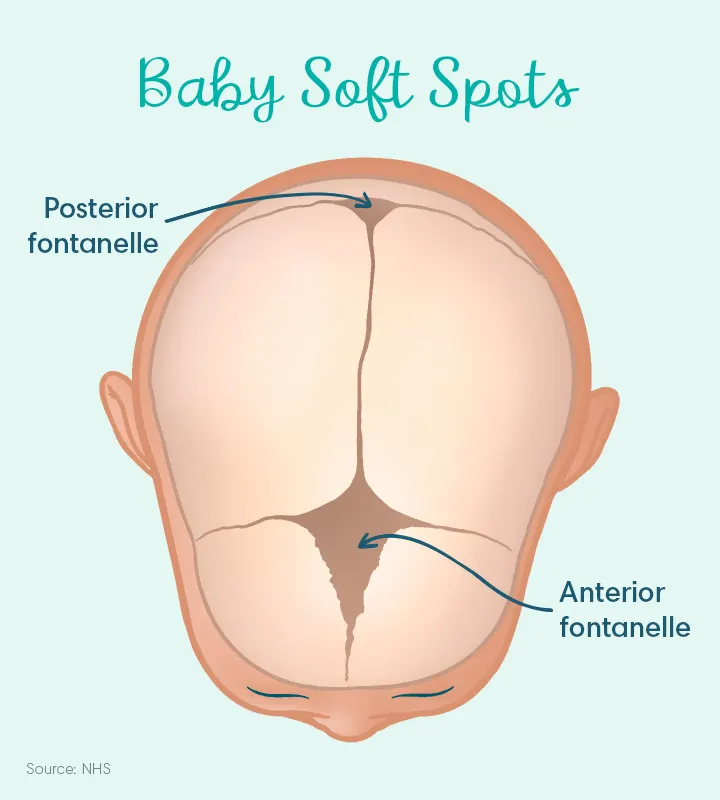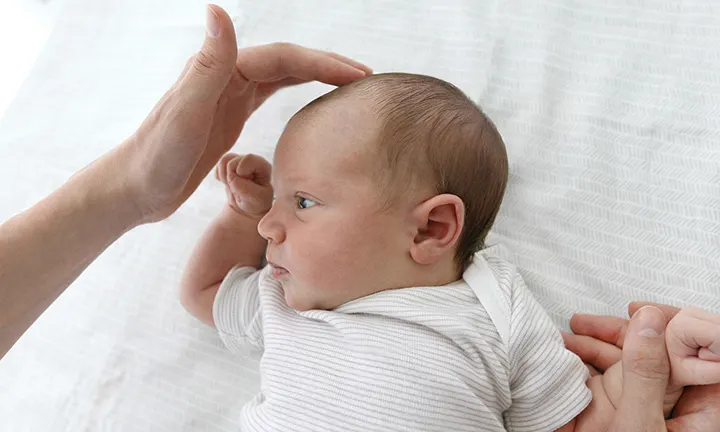Fontanelles Explained: Your Baby's Soft Spots
One of the first things you might notice about your newborn baby is a couple of soft spots on the head. These soft spots are called fontanelles, and they’re perfectly normal. In fact, they play an important role in your baby’s development. Learn about your baby’s soft spots, how to protect them, when the fontanelles are likely to close and which warning signs to look out for.
What and Where Are Baby Soft Spots?
All babies are born with two soft spots (fontanelles) on their heads, where the bones that form the skull haven’t yet fused together. The larger soft spot (anterior fontanelle) is toward the front of the head; while there is another, smaller soft spot (the posterior fontanelle) towards the back.

Why Do Babies Have Soft Spots?
The soft spots on your baby’s head have two main functions:
They make it possible for the bony plates of the skull to compress and overlap as the head passes through the narrow birth canal during a vaginal delivery
They allow your baby’s skull to expand, making room for the rapid brain growth that happens in the first year.
At What Age Do Fontanelles Close?
When your baby is newborn, both soft spots should be open and flat. Sometime in the first two months or so, the soft spot at the back of your baby’s head may close. The soft spot at the front takes longer to close up – this often happens by the time your toddler turns 18 months old.
What Happens If You Touch the Soft Spot on a Baby's Head?
As long as you touch your baby’s soft spots gently and make sure your infant’s head and neck are always supported when holding or bathing your newborn, you needn’t be afraid of hurting him or her. There’s a thick and durable membrane just under your baby’s scalp that protects your little one’s brain, so gently touching or washing the fontanelle area won’t do any harm.
Why Is Your Baby's Soft Spot Pulsating?
Sometimes your baby’s soft spot may seem to be pulsating or moving. This is completely normal. The fontanelle may move as your baby breaches, so there’s no need to worry if you see your baby’s soft spot pulsing.
When Should You Be Concerned About Your Baby's Soft Spot?
The lack of soft spots on your baby’s head may be a sign of very rare condition called craniosynostosis, a birth defect in which your baby’s skull bones fuse together earlier than normal, resulting in a misshapen head. Craniosynostosis is treatable and doesn’t cause lasting health problems in most children. Talk to your midwife, health visitor or doctor if
your baby seems to have no soft spots
your baby’s head seems long and narrow, like a rugby ball
your baby has a pointy or triangular forehead
one side of your baby’s head is bulging out or flattened
the soft spot on top of your baby’s head closes before the age of 1 year old
your baby’s head seems small for his or her body.
Your doctor can assess whether it really is craniosynostosis or if your baby has flat head syndrome, a common condition where prolonged pressure on the softer skull bones – for example, from too much time lying in the same position – can cause flat spots that often disappear by themselves.
In Summary See your doctor if your infant doesn’t seem to have soft spots, if the soft spot on top of your baby’s head closes up too soon or you’re concerned about the shape of your little one’s head. In many cases, a misshapen head is harmless, but it’s important to have it checked out in case any treatment is needed. |
What Does It Mean When a Baby’s Soft Spot Is Sunken In?
A sunken soft spot could be a sign of dehydration, which can happen if your baby is not getting enough breast milk or formula. Your baby has a higher risk of becoming dehydrated in hot weather or if he or she has
Besides a sunken soft spot, these are some of the other signs of dehydration:
Fewer wet nappies
Dark yellow pee
Sunken eyes
Few or no tears when crying
A dry mouth
Cool skin
Drowsiness
Irritability.
Take your baby to the doctor or your local A&E straight away if you notice any of the above symptoms or are concerned your newborn may be dehydrated.
In Summary Seek immediate medical attention if you notice signs of dehydration in your baby, such as a sunken fontanelle, fewer wet nappies, dry mouth and eyes, drowsiness or irritability. |
What Does a Bulging Soft Spot Mean?
A bulging fontanelle could be a sign of meningitis, an inflammation of the membranes surrounding the brain and spinal cord. Meningitis requires urgent treatment to prevent serious complications, so if you notice this or any other possible symptoms call an ambulance or go straight to A&E. Other symptoms of meningitis can include:
Fever
Cold hands and feet
Refusing feeds
Stiff neck or body
Floppiness, unresponsiveness
A high-pitched cry
Irritability
A rash or spots
Sensitivity to bright light
Vomiting
Seeming dazed
Rapid breathing.
The Bottom Line
Although finding soft spots on your baby’s head might seem alarming at first, fontanelles are perfectly normal and serve two important purposes: to make it easier for your baby to pass through the birth canal during a vaginal delivery and to make room for your little one’s brain to grow. By around 18 months even the larger soft spot on top of the head will be gone, although by then you may be so used to it being there that you don’t notice it straight away. One day, when you stroke or plant a kiss on your baby’s head, you might be surprised to find hard bone where the soft spot used to be.
The information in this article is based on the expert advice found in trusted medical and government sources, such as the National Health Service (NHS). You can find a full list of sources used for this article below. The content on this page should not replace professional medical advice. Always consult medical professionals for full diagnosis and treatment.
Join Pampers Club and get:





